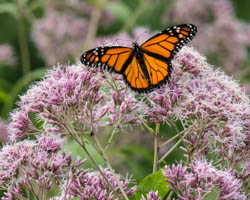Vol. 20 Issue 4, Winter 2015
By Nicole Hamilton

Monarch on Joe Pye weed
Photo by Nicole Hamilton
As you read this, Monarch butterflies rest by the millions in Oyamel fir trees in a tiny mountain town outside of Mexico City. These butterflies lived in our gardens. They gobbled up milkweed as caterpillars and sipped nectar as adults. They sat on our fingers and danced through our lives and then, one day last fall, they looked to the southwest and flew.
The trip was long and we held our breath as Hurricane Patricia rolled through their migratory path. After a brief pause, they flew on. Finally, on November 4, via our friends at Journey North and Monarch watcher Estela Romero, we heard the news: “The massive arrival started at noontime today. Monarchs suddenly and clearly came from the north side of our town.”
This winter, scientists will once again go to the Monarch sanctuaries and estimate the health and size of the populations. It may be a few more weeks before we have the official totals but Dr. Chip Taylor, Director of Monarch Watch, estimates based on last spring’s weather conditions and milkweed growth, we may see a doubling of the population over last year. This would be great news but we have a long way to go in bringing back the Monarchs. The challenge is that there is only so much milkweed growing and it is not clear there is enough to sustain the current population, let alone allow for it to increase. So what do we do? Plant! We plant our gardens with milkweed and other wildflowers, we talk to our friends about planting milkweed and continue our work restoring and creating milkweed habitat large and small.
2015 was the third year of our Monarch campaign in Loudoun. We reached over 2,000 people through our events. We sold over 5,500 milkweed plants and countless other native plants at our native plant sales. We donated 300 milkweed plants to 8 local schools and supported them in creating Monarch waystations.
We also built a partnership with VDOT. Through a series of meetings with VDOT leaders, including the commissioner, we shared the story of the plight of the Monarchs, provided recommendations and discussed the role VDOT could play in Monarch and pollinator recovery. This has been a very positive partnership.
VDOT has already changed their mowing standards to make sure that native wildflowers, including milkweed, will be protected in the future. They are also discussing ways to reduce herbicide applications. Shifting from turf management to wildflowers is also in the works. VDOT is looking into sources and types of native seed mixes and is testing seed germination rates and best methods for seed planting. As the appearance of our roadways transform, VDOT wants people to understand why so they are creating Monarch waystations/pollinator plots with education kiosks at all 43 rest stops over the next 5-6 years.
VDOT’s large land area is a critical part of the Monarch recovery plan and pollinator health. It is wonderful to know that as Monarchs lift off from our gardens, they will find more milkweed and other native wildflowers along their journey. Every plant counts!

